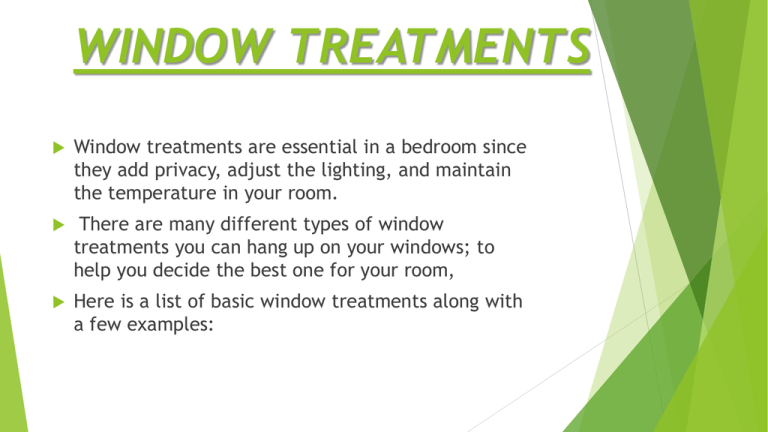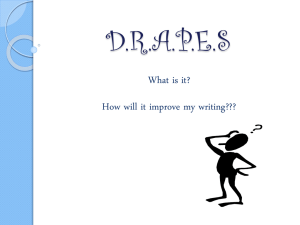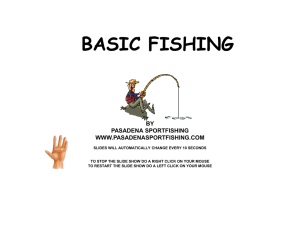CURTAINS - Department of Architecture
advertisement

WINDOW TREATMENTS Window treatments are essential in a bedroom since they add privacy, adjust the lighting, and maintain the temperature in your room. There are many different types of window treatments you can hang up on your windows; to help you decide the best one for your room, Here is a list of basic window treatments along with a few examples: CURTAINS Curtains are the most popular and common window treatment used in homes, especially bedrooms. They come in several different styles, colors, and patterns that offer many options as well as function. Typically, curtains are made of lighter weight fabric and sold in packages containing two panels. They are made to hang from a curtain rod or curtain rings attached to a rod, which is installed just above the window frame. There are many different types and ways to hang and drape curtains; usually they’re hung on a rod through a rod pocket using rings or pleated. CURTAINS Since curtains often come in many different lengths-to fit basic window measurements there are several ways to hang up curtains as well as tie-back the panels; some methods include puddling the curtain panel on the floor, basic right or left tie-back, and cascading Examples of curtain designs DRAPES Drapes are similar to curtains-sold in panels of fabric with many different lengths, colors, and patterns—but are normally made of heavier fabric, lined, pleated and hung on a traverse rod with a string so you can easily open and close them. Drapes are more grand and found in formal-type rooms, such as a dining room, parlor, or master bedroom. DRAPES Designer Tip: Having trouble keeping your room warm, cold, or dark for some good sleep? Blackout drapes are a great solution for keeping daylight as well as cold and warm drafts out of a bedroom. Examples of drape designs SHEERS Sheers are typically used with curtains and drapes for added decoration and don’t offer much privacy or shade from the sun. If sheers are used in bedrooms it’s normally used in small bedrooms to add sunlight to make the room appear larger or to add soft, frilly decor in nurseries and little girl’s bedrooms. SHEERS Types of sheer curtains 1.Rod-pocket drapes, also called pole-pocket drapes, are made with a casing at the top that slips over a curtain rod, removing the need for rings. Sheer fabric curtains are often made with two rod pockets at the top, so that you can slide the curtain rod through the lower pocket, and a soft ruffling effect is created by the unused top pocket. These are great for making the curtain feel as though it is integrated into the wall, because the rod is nearly invisible under the drapes. 2.Tab-top curtains are great for a casual ambience. They are made with flat loops spaced along the top edge of the curtain, through which the rod goes. These also do not require curtain rings. They can easily be drawn open or closed without pull cords. 3.Ring-top drapery is hung on decorative curtain rings that are attacked to the drapes at intervals across the top. The rings are ideal for showing off a design-centric curtain rod. Like tabtop drapes, these do not require a pull cord to open or clothes. 4. Grommet-top curtains are relatively new. A curtain rod passes through the large grommet rings (holes) at the top of the curtain, creating a broadly pleated look. This is great for a crisp, modern room, such as a lounge or a study. SHEERS Advantages and Disadvantages of sheer curtains Sheer curtain panels are delicate window or glass coverings made of somewhat transparent materials. They may serve to bring a light, breezy feel to a room, or serve as an additional layer of concealment under heavier curtains. Price can be an excellent advantage of sheer curtain panels. Typically far less expensive than traditional curtains, panels are found at nearly every home decor or home supply store, and can be easily ordered online. The low cost of many types of these panels allows the smart decorator to have the option of changing them frequently; some people have several sets that can be switched out seasonally, turning a summery sage into a fiery autumn orange into a lovely pine green for the holidays. The cons of sheer curtain panels depend on the situation. As they are made of light fabrics, they are very poor insulators and may allow rooms to grow much hotter in warm weather or chillier in cool weather. This may be a problem for those with poor insulation systems to begin with, or for those who try to reduce heating and cooling costs by mitigating insulation problems. As they are sheer, the panels do not usually provide much privacy. While this may not matter in a kitchen or living room, sheer panels in a bathroom or bedroom may be a problem for some. This matter is often solved by using a second layer of thicker curtains to provide additional privacy. Examples of Sheers design BLINDS Blinds are simple, modern window treatments that are wonderful for bedrooms because they add the privacy needed as well as block out sunlight. Blinds are made from hard materials, such as wood, metal, or vinyl. BLINDS They have slats or louvers, where these long pieces of hard materials are fitted and then adjusted by strings to monitor the amount of light in the room. Blinds are hung vertically or horizontally and come in many different styles, which include Venetian, mini, and vertical Examples of blinds SHUTTERS Shutters are an old window treatment that is a solid wood door inserted within the window casement or frame on hinges that enables the shutter to be opened to expose the window. They also have small blinds that can be open and shut using a lever to filter the light while they're closed SHUTTERS Shutters are normally made of wood but there are some made of fauxwood, which come in white, black, brown, or many different type of wood finishes Examples of shutters designs SHADES Shades are another popular choice besides curtains because they regulate the amount of light and offer many beautiful decorative alternatives. Shades are portions of fabric cut to the shape of a window frame, which pulls up-anddown from the top by a string through a pulley-type system or a roll-up sprocket mechanism SHADES Shades are often preferred over blinds because there are many different types of styles and materials, such as bamboo, cellular (translucent), Roman, pleated, solar, motorized, balloon, roller (basic type), and many more. Examples of Shades designs VALANCES Valances are decorative top treatments used with drapes, curtains, or shades for added decoration and to conceal the mounting hardware. Valances are swathes of fabric draped around the top of a window frame that can be pleated, arched, gathered or flat, straight or shaped, and mounted on dust boards, poles or rods. VALANCES Due to their dramatic effect, they're normally found in formal rooms, such as master bedrooms, parlors, or dining rooms. VALANCES Types of valances Tailored Valance A tailored valance is a plain topper that is flat, square or rectangular. It looks tailored because of its clean, straight lines. There is no inner stuffing such as those found in some balloon valances. Attach a tailored valance to a piece of lumber, then hang it on top of the window using L-hooks, or insert a rod through the pockets. Add depth by gathering the top of the tailored valance to create pleats. Use tailored valances in a variety of decorating styles, from traditional to contemporary designs. Balloon Valance Soften the look of a room with billowing balloon valances. Gather the lightweight fabric and insert stuffing of tissue paper or plastic bags to add a pouf. Or create the pouf without the stuffing by sewing the top seams tightly in intervals. Hang balloon valances using rods. Use balloon shades in a formal or traditional room. Add a romantic and feminine touch to a girl's bedroom with balloon valances. Ascot Valance The shape of an ascot valance is triangular. Use soft fabrics such as sheers and cotton for an informal look, or use lined fabrics such as velvet and silks for a more formal look. Purchase ready-made ascot valances from department stores. Embellish the pointed end of the ascot valance with buttons, tassels, beads, pearls, buttons and ornaments to add flair. Swag Valance Often used in a formal setting, a swag valance is more ornate in appearance, created by draping the fabric over the rod. Leave both ends hanging. Hang it on top of drapery panels or a plain window to soften the edges. Examples of Valances designs CORNICES Cornices are sleek hard window treatments that are padded box shapes covered in paint, wallpaper, or fabric and mounted above the window to conceal the mounting hardware. The bottom of a cornice can be shaped and trimmed in many different ways and some opt to have their cornices custom made to match the material of their furniture. Types of cornices designs Box cornice Box cornices enclose the cornice of the building with what is essentially a long narrow box. A box cornice may further be divided into either the narrow box cornice or the wide box cornice type. A narrow box cornice is one in which "the projection of the rafter serves as a nailing surface for the soffit board as well as the fascia trim. This is possible if the slope of the roof is fairly steep and the widths of the eave relatively narrow. A wide box cornice, which is common practice on houses with gentle roof slopes and wide eaves, requires the use of lookouts to give it support and to provide a surface to which to securely attach the soffits. Box cornices often have ventilation screens laid over openings cut in the soffits in order to allow air to circulate within the cornice. Close cornice A close, closed, or snub cornice is one in which there is no projection of the rafters beyond the walls of the building, and therefore no soffit and no fascia. This type of cornice is easy to construct, but provides little aid in dispersing water away from the building and lacks aesthetic value. Open cornice In an open cornice, the shape of the cornice is similar to that of a wide box cornice except that both the lookouts and the soffit are absent. It is a lower-cost treatment that requires fewer materials, and may even not have a fascia board, but lacks the finished appearance of a box cornice. Examples of cornices designs


![The mysterious Benedict society[1]](http://s2.studylib.net/store/data/005310565_1-e9948b5ddd1c202ee3a03036ea446d49-300x300.png)



